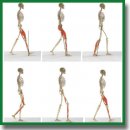
Application of 2D Gait Analysis for the Assessment of Gait Disturbance in Patients with Spastic Tetraparesis
The aim of the study was to explore the use of 2D gait analysis for assessing gait abnormalities in patients with spastic tetraparesis associated with spinal cord injury and other lesions of the cervical spinal cord.
Materials and Methods. The study included 12 patients with tetraparesis of various etiologies. Gait assessment was performed by video analysis using reflective markers (1.5 cm) and a special walking platform. The spatial coordinates of the markers were determined by capturing the reflected light with infrared LEDs located around the lenses of video cameras.
Results. Using 2D gait analysis, numerical indicators of gait disturbance in spastic tetraparesis were obtained. We found a prolongation of the stand phase with a shortening of the swing phase (from 81.9 [76.1; 89.2] to 85.3 [74.4; 90.2]%; p=0.97) and the period of the double step (from 0.50 [0.45; 0.96] to 0.40 [0.34; 0.66]; p=0.4) in comparison with the target (normal) values (60% — for the stand phase; 1.41 — for the double-step period). The movements in the hip, knee, and ankle joints are described using numerical values.
We then compared the data obtained from the left and right sides of the patient’s body: there were no statistically significant differences between the two sets of data. We also compared the gait characteristics before and after treatment (in 4 patients). Statistically significant differences in values were obtained for the stand and swing phases (p=0.035), the range of motion in the hip joint (p=0.01), and gait velocity (p=0.046). Kendall’s analysis revealed no significant correlation between the data obtained by video gait analysis and the gait changes by the Modified Ashworth Scale (р>0.05).
Conclusion. 2D gait analysis is a promising method for quantifying gait disturbance in patients with spastic tetraparesis. It allows one to identify characteristic gait patterns, in particular, an increase in the stand phase with a shortening of the swing phase and the double step period, as well as a decrease in the range of motion in the hip joints with an increase in the knee and ankle ones.
- Janssen I., Nouri A., Tessitore E., Meyer B. Cervical myelopathy in patients suffering from rheumatoid arthritis — a case series of 9 patients and a review of the literature. J Clin Med 2020; 9(3): 811, https://doi.org/10.3390/jcm9030811.
- Ponomarev G.V., Skoromets A.A., Krasnov V.S., Rodionova O.V., Glistenkova D.D., Porkhun N.F., Dambinova S.A. Vascular myelopathy: causes and mechanisms, possibilities of diagnosis and treatment. Nevrologia, nejropsihiatria, psihosomatika 2018; 10(1): 12–16, https://doi.org/10.14412/2074-2711-2018-1-12-16.
- Natale M., Mirone G., Rotondo M., Moraci A. Intrathecal baclofen therapy for severe spasticity: analysis on a series of 112 consecutive patients and future prospectives. Clin Neurol Neurosurg 2012; 114(4): 321–325, https://doi.org/10.1016/j.clineuro.2011.10.046.
- Fjelstad A.B., Hommelstad J., Sorteberg A. Infections related to intrathecal baclofen therapy in children and adults: frequency and risk factors. J Neurosurg Pediatr 2009; 4(5): 487–493, https://doi.org/10.3171/2009.6.peds0921.
- Pittelkow T.P., Bendel M.A., Lueders D.R., Beck L.A., Pingree M.J., Hoelzer B.C. Quantifying the change of spasticity after intrathecal baclofen administration: a descriptive retrospective analysis. Clin Neurol Neurosurg 2018; 171: 163–167, https://doi.org/10.1016/j.clineuro.2018.06.010.
- Biering-Sørensen F., Nielsen J., Klinge K. Spasticity-assessment: a review. Spinal Cord 2006; 44(12): 708–722, https://doi.org/10.1038/sj.sc.3101928.
- Ashworth B. Preliminary trial of carisoprodol in multiple sclerosis. Practitioner 1964; 192: 540–542.
- Suponeva N.A., Yusupova D.G., Zhirova E.S., Melchenko D.A., Taratukhina A.S., Butkovskaya А.A., Ilyina K.A., Zaitsev A.B., Zimin A.A., Klochkov A.S., Lyukmanov R.Kh., Kalinkina M.E., Piradov M.А., Kotov-Smolensky A.M., Khizhnikova A.E. Validation of The Modified Rankin Scale in Russia. Nevrologia, nejropsihiatria, psihosomatika 2018; 10(4): 36–39, https://doi.org/10.14412/2074-2711-2018-4-36-39.
- Langerak N.G., Lamberts R.P., Fieggen A.G., Peter J.C., Merwe L., Peacock W.J., Vaughan C.L. A prospective gait analysis study in patients with diplegic cerebral palsy 20 years after selective dorsal rhizotomy. J Neurosurg Pediatr 2008; 1(3): 180–186, https://doi.org/10.3171/ped/2008/1/3/180.
- Borzikov V.V., Rukina N.N., Vorobyova O.V., Kuznetsov A.N., Belova A.N. Human motion video analysis in clinical practice (review). Sovremennye tehnologii v medicine 2015; 7(4): 201–210, https://doi.org/10.17691/stm2015.7.4.26.
- Morozov I.N. Pozvonochno-spinnomozgovaya travma: vosstanovitel’noe lechenie v promezhutochnom i pozdnem periodakh. Avtoref. dis. … dokt. med. nauk [Spinal cord injury: rehabilitation treatment in the intermediate and late periods. DSc Thesis]. Moscow; 2011.
- Vitenzon A.S., Petrushanskaya K.A., Skvortsov D.V. Rukovodstvo po primeneniyu metoda iskusstvennoy korrektsii khod’by i ritmicheskikh dvizheniy posredstvom programmiruemoy elektrostimulyatsii myshts [Guidelines for the application of the method of artificial correction of walking and rhythmic movements through programmed electrical muscle stimulation]. Moscow; 2005.










